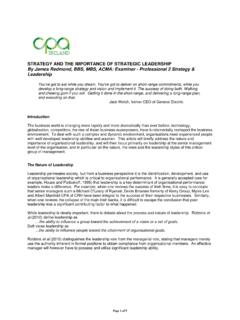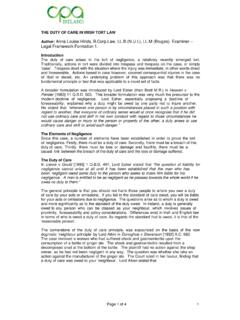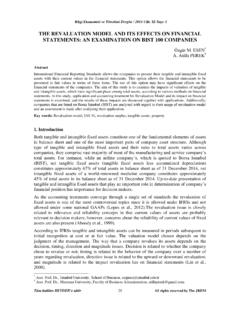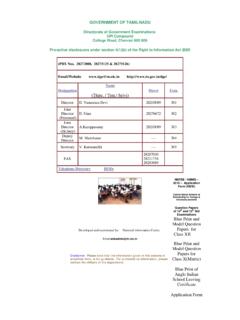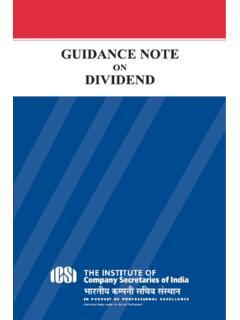Transcription of IAS 16 Property, Plant & Equipment Revaluations.
1 Page 1 of 9 IAS 16 Property, Plant & Equipment Revaluations. By: Conor Foley, B. Comm., MAcc., ACA, Dip IFR. Lecturer in Accounting Limerick Institute of Technology. Examiner: Formation 2 Financial Accounting. This article deals with IAS 16 Property, Plant and Equipment (PPE) and the accounting treatment for revaluation of tangible non-current assets Introduction IAS 16 deals with PPE which are tangible assets that are held for use in the production of goods or delivery of services or for an administrative purpose, and are expected to be used for more than one accounting period are non-current in nature. Typical examples of PPE include land, buildings, Equipment , furniture and fixtures, motor vehicles, ships, aircraft and Plant and machinery. Measurement at recognition The only allowable model for initial recognition of PPE is at cost as per IAS 16.
2 Measurement after recognition There are two allowable models for measurement of PPE after initial recognition; Cost model , or revaluation model revaluation model After initial recognition as an asset, PPE shall be carried at a revalued amount provided its fair value can be measured reliably. This revalued amount is its Fair value at the date of revaluation less any subsequent accumulated depreciation and less any subsequent accumulated impairment losses. Revaluations need to be made with sufficient regularity to ensure that the carrying value does not differ materially from that which would be determined using fair value at the end of the reporting period. The frequency of revaluations depends upon the changes in fair values of the items of PPE being revalued. If the fair value of a revalued asset differs materially from its carrying value, then a further revaluation is required.
3 If a PPE experiences significant and volatile changes in its fair value, it may be necessary to revalue on an annual basis. Otherwise, every three to five years may be an acceptable time period between revaluations. Page 2 of 9 For example, if we take the property market in Ireland over the last ten years, the period between 2001 and 2007 was where buildings, in general, experienced high increases in their market value due to low interest rates, ready availability of credit and confidence in the sector. As a result, property prices increased sizeably in value annually and therefore, if a company was using the revaluation method in relation to buildings, there may have been a necessity to revalue the buildings annually, using a professionally qualified valuer, to ensure that the company complied with IAS 16. From 2007, property prices in Ireland have plummeted and again, a company may have to revalue annually due to the sizeable decreases year-on-year in property prices so as to comply with the standard.
4 When an item of PPE is revalued, there are two methods of dealing with accumulated depreciation with the most commonly used method being the following whereby; Accumulated depreciation is eliminated against the gross carrying value of the asset and the net amount restated to the revalued amount of the asset. Example A building was purchased on the 1st January 2006 at a cost of 100 million. It is being depreciated over 50 years. The company decided to use the revaluation model for valuing buildings in 2011 and at the 31st December 2011, the building was valued at 80 million by a professional valuer. Solution By the 31st December 2011, the asset has been depreciated for 6 years. This means that the accumulated depreciation is 12 million ( 100 million / 50 years * 6 years). Per IAS16, this accumulated depreciation is netted against the cost; Cost 100 million less Accumulated Depreciation 12 million Carrying Value 88 million This carrying value of 88 million is compared against the revalued amount of 80 million and a revaluation loss of 8 million needs to be accounted for.
5 revaluation & Class of Assets If PPE is revalued, then the entire class of PPE to which that asset belongs also needs to be revalued if a company owns 5 buildings which it uses for storing grain and they decide to revalue 1 building, then per IAS 16, all buildings have to be revalued as they belong to the same class or category under PPE they are of a similar nature and use in the company s operations revaluation Gains If an asset s carrying amount is increased as a result of a revaluation , the increase shall be recognised in the Other Comprehensive Income (OCI) section of the Statement of Comprehensive Income (SOCI) and included in the Equity section of the Statement of Financial Position (SOFP) under the heading of a revaluation surplus. The double entry for this is shown on the following page: Page 3 of 9 Dr. PPE Non-Current Assets (SOFP) X Cr.
6 OCI (SOCI) X Example A company revalued their land from 200,000 to 300,000. The profit for the year from normal day to day activities of the company is 350,000 and at the start of the year there was a revaluation surplus of 75,000. The retained earnings at the start of the year amounted to 120,000. The ledger entry and the extracts from the SOCI and SOFP for this revaluation are shown below: Solution The ledger entry is as follows: Dr. PPE (SOFP) 100,000 Cr. OCI (SOCI) 100,000 Extract from SOCI Profit for the Year 350,000 Other Comprehensive Income revaluation Gain from Land 100,000 Total Comprehensive Income for the Year 450,000 Extract from SOFP Non-Current Assets PPE 300,000 Total Non-Current Assets 300,000 Equity Retained Earnings (120,000 + 350,000) 470,000 revaluation Surplus (75,000 + 100,000) 175,000 Total Equity 645,000 Note that the Total Comprehensive Income amount of 450,000 is taken to the Equity section of the SOFP but 350,000 of it goes to retained earnings and the 100,000 revaluation gain is added to the revaluation surplus.
7 In relation to revaluation gains on PPE, an increase or gain shall be recognised in profit or loss to the extent that it reverses a revaluation decrease of the same asset previously recognised in profit or loss. Page 4 of 9 Example A company revalued their land from 200,000 to 300,000. Previously, the same land had been revalued downwards from 260,000 to 200,000 creating a revaluation loss of 60,000 which was taken to profit or loss as there was no revaluation surplus as this was the first time the asset had been revalued. The profit for this year from normal day to day activities of the company before revaluation is 300,000 and at the start of the year the retained earnings amounted to 150,000. The ledger entry and the extracts from the SOCI and SOFP for this transaction are shown below: Solution The ledger entry is as follows: Dr.
8 PPE (SOFP) 100,000 Cr. Profit or Loss (SOCI) 60,000 Cr. OCI (SOCI) 40,000 Extract from SOCI Profit for the Year 300,000 revaluation Gain 60,000 Profit for the Year 360,000 Other Comprehensive Income revaluation Gain from Land 40,000 Total Comprehensive Income for the Year 400,000 Extract from SOFP Non-Current Assets PPE 300,000 Total Non-Current Assets 300,000 Equity Retained Earnings (150,000 + 360,000) 510,000 revaluation Surplus 40,000 Total Equity 550,000 Page 5 of 9 revaluation Losses If an asset s carrying amount is decreased as a result of a revaluation , the decrease shall be recognised in profit or loss. However, the decrease shall be recognised in OCI to the extent of any credit balance existing in the revaluation surplus in respect of that asset. The decrease recognised in OCI reduces the amount accumulated in equity under the heading of revaluation surplus.
9 The double entry for this is as follows: Dr. OCI (SOCI) (If revaluation Surplus already in Accounts) X Cr. PPE Non-Current Asset (SOFP) X Up to the maximum of a revaluation surplus and the balance being accounted as follows: Dr. Profit or Loss (SOCI) X Cr. PPE Non-Current Assets (SOFP) X Example A company revalued their land from 500,000 to 400,000. The profit for the year from normal day to day activities of the company is 300,000 and at the start of the year there was a revaluation surplus of 75,000. The retained earnings at the start of the year amounted to 180,000. The ledger entry and the extracts from the SOCI and SOFP for this transaction follow: Solution The ledger entry is as follows: Dr. OCI (SOCI) 75,000 Dr. Profit of Loss (SOCI) 25,000 Cr.
10 PPE (SOFP) 100,000 Extract from SOCI Profit for the Year 300,000 revaluation Loss (25,000) Profit for the Year 275,000 Other Comprehensive Income revaluation Loss (75,000) Total Comprehensive Income for the Year 200,000 Page 6 of 9 Extract from SOFP Non-Current Assets PPE 400,000 Total Non-Current Assets 400,000 Equity Retained Earnings (180,000 + 275,000) 455,000 revaluation Surplus (75,000 - 75,000) 0 Total Equity 455,000 Note that the Total Comprehensive Income amount of 200,000 is taken to the Equity section of the SOFP but 275,000 of it goes to retained earnings and the 75,000 revaluation loss is taken from the revaluation surplus brought forward. The revaluation surplus included in equity in respect of PPE may be transferred directly to retained earnings when the asset is derecognised.



